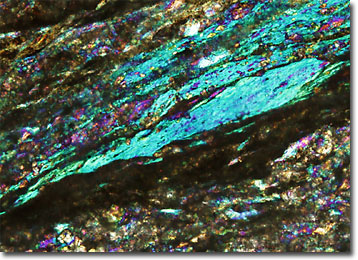Polarized Light Microscopy Digital Image Gallery
Greenstone
Greenstone is a term generally applied to any basic igneous rock that has undergone low-grade metamorphism and exhibits a light to dark green color. The distinctive hue of greenstone derives from the presence of epidote, actinolite, chlorite, or other characteristically green minerals.

Many of the oldest rocks on Earth are greenstones, and some of the oldest fossils ever identified may be found among them. In fact, during the 1990s, it was suggested that microscopic structures found in 3.465-billion-year-old Western Australian greenstones were the fossils of 11 different species of bacteria. If this proposal is true, the fossils in the greenstones formed more than a billion years before the oldest undisputed bacterial fossils. Such information would undeniably indicate that life on Earth developed much earlier than was previously supposed. However, the evidence supplied regarding the rocks and possible fossils is contentious and scientists have yet to come to a consensus regarding the matter.
Not only do greenstones provide important geological clues regarding the history of the Earth, but they are also an economically important type of rock due to the valuable ores they often contain. Indeed, gold, silver, iron, copper, chromium, barium, nickel and a number of other metals may be found in belts of greenstone, where they are frequently heavily mined. Compact and hard, greenstones have occasionally been utilized as building stones as well. One of the most famous buildings constructed from the material is Bolingbroke Castle in Lincolnshire, England, which was established in the early thirteenth century and is particularly notable for being the birthplace of King Henry IV.
